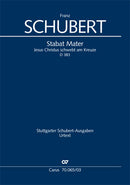| 作曲者 | Franz Schubert (1797-1828)・フランツ・シューベルト |
| タイトル | Stabat Mater, D 383(ヴォーカル・スコア) |
| 出版社 | Carus・カールス |
| シリーズ名 | Stuttgart Schubert Edition |
| 楽器編成(詳細) | Soli STB,Coro SATB,2 Fl,2 Ob,2 Fg,Cfg,2 Cor,3 Trb,2 Violins,Viola,Cello,Contrabass |
| 品番 | M007166007 |
| 校訂者 | Stefan Schuck |
| 難易度 | 中級 |
| 言語 | ドイツ語 |
| 形状 | 64 ページ・19 x 27 cm・180 g・ソフトカバー |
| 演奏時間 | 37分 |
| 出版年 | 2018年 |
| 出版番号 | CV 70.065/03 |
| ISMN | 979-0-007-16600-7 |
| サンプル | https://www.carusmedia.com/images-intern/medien/70/7006503/7006503x.pdf |
In spring 1816 Franz Schubert, just nineteen years old, completed his second setting of the "Stabat Mater" in the midst of a highly productive period. In contrast with his first setting written the previous year, just five minutes in length, this time Schubert used the German translation by Klopstock as the basis for his composition. Stefan Schuck’s edition is the first one of this work to be based on a critical evaluation of the primary sources, with complete performance material. The work, in a dark F minor, with its text by Klopstock, places Jesus Christ, rather than Mary, at the center of the contemplation. With his fugues, but particularly in the eight-part lamenting chorus "Wer wird Zähren sanften Mitleids", Schubert shows himself at the height of his creative output. He composed his 4th Symphony, the "Tragic", at almost the same time. The Stabat Mater is a rewarding work for choral societies and choirs to perform, because the choir has the largest portion to sing, and the choral parts are not too demanding. The composition is also a beautiful introduction to the choral-symphonic music of Schubert for less experienced choirs.



